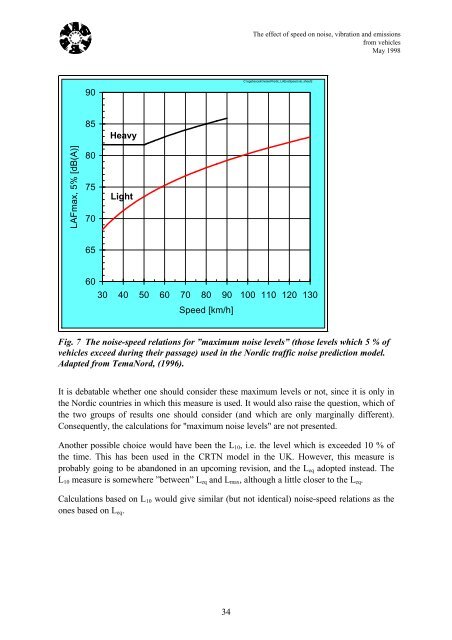appendix a - Velocidade
appendix a - Velocidade
appendix a - Velocidade
You also want an ePaper? Increase the reach of your titles
YUMPU automatically turns print PDFs into web optimized ePapers that Google loves.
LAFmax, 5% [dB(A)]<br />
90<br />
85<br />
80<br />
75<br />
70<br />
65<br />
60<br />
Heavy<br />
Light<br />
30 40 50 60 70 80 90 100 110 120 130<br />
Speed [km/h]<br />
34<br />
The effect of speed on noise, vibration and emissions<br />
from vehicles<br />
May 1998<br />
C:\eget\exceln\noise\Predic_LAEvsSpeed.xls_sheet2<br />
Fig. 7 The noise-speed relations for ”maximum noise levels” (those levels which 5 % of<br />
vehicles exceed during their passage) used in the Nordic traffic noise prediction model.<br />
Adapted from TemaNord, (1996).<br />
It is debatable whether one should consider these maximum levels or not, since it is only in<br />
the Nordic countries in which this measure is used. It would also raise the question, which of<br />
the two groups of results one should consider (and which are only marginally different).<br />
Consequently, the calculations for "maximum noise levels" are not presented.<br />
Another possible choice would have been the L10, i.e. the level which is exceeded 10 % of<br />
the time. This has been used in the CRTN model in the UK. However, this measure is<br />
probably going to be abandoned in an upcoming revision, and the Leq adopted instead. The<br />
L10 measure is somewhere ”between” Leq and Lmax, although a little closer to the Leq.<br />
Calculations based on L10 would give similar (but not identical) noise-speed relations as the<br />
ones based on Leq.


